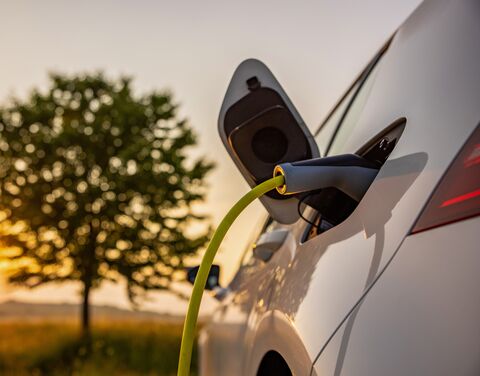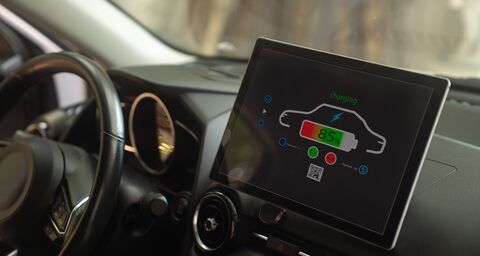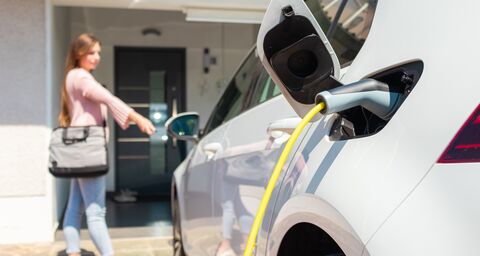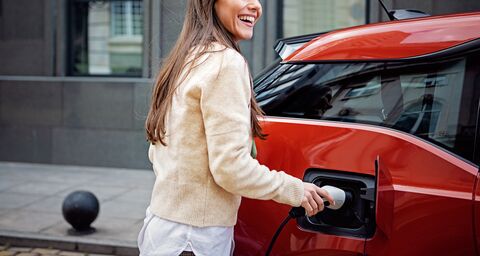
Bidirectional charging – the future of electromobility?
Bidirectional charging means being able to use an electric vehicle to not only receive electricity, but also to store electricity and feed it back into the grid. If you own an EV, it’s well worth looking into this new development, and this article will tell you all about it.
Storing electricity with your car
Often the main problem with renewable energy is storing the electricity. This is because the solar panels on your roof generate electricity when the sun is shining, which is not necessarily when you need the electricity. Ideally, this surplus energy should be stored somewhere. There are special batteries that do this, but this is an added cost. This is where bidirectional charging comes in. It allows your EV to be used as a battery to store this energy. Usually you charge your EV with electricity so you can drive it. But with the right technology, you can pull electricity from your car, which lets you store excess energy from your solar panels, for example, and feed it back into the grid later on.
Direct and alternating current – the technical lowdown
In charging and discharging, the difference between direct and alternating current plays a decisive role. Alternating current (AC) is what is used in households. When transferring energy between the grid and an electric vehicle, alternating current is generally converted to direct current by an internal converter in the on-board charger (OBC) of the vehicle in order to charge the car battery. For the house or the grid to be able to use the electricity, it must be able to flow in the other direction. This is why the Wallbox or the car needs to have a converter, which enables the battery to convert the direct current from the battery to alternating current.
This way electricity from the car can be used elsewhere.
There are various ways in which the electricity stored in the car can be used. They are usually referred to as Vehicle-to-Everything, or V2X for short. Below is a rundown of the three most popular options:
- V2L: Vehicle-to-Load is very simple. The car has a built-in plug which allows you to plug in your devices to power them. This is practical for when you go camping or for any of your devices that you use everyday and need to charge regularly.
- V2H: Vehicle-to-Home is just what it says – using the battery in your car to supply power to your house. The car remains plugged into the wallbox in your garage and when you need it, you can use this electricity for your home. If you own your home and have a photovoltaic installation, this is an especially interesting option because the battery serves as interim storage for the energy captured from the sun.
- V2G: Vehicle-to-Grid means feeding extra energy back into the grid in order to offset fluctuations and load peaks. In the interest of sustainability and supplying the needs of society with renewable energies, this last option certainly has the greatest potential for the future.
Important standard for bidirectional charging
ISO 15118-20 is an international standard for bidirectional charging of electric vehicles. It defines the interfaces and communication protocols between the vehicle and the charging infrastructure. It also defines how information about the battery’s state of charge and the current flow is exchanged.
Areas of application and functions of bidirectional charging
Bidirectional charging has the potential to be applied in different areas, making a significant contribution to the energy transition and to sustainable energy supply.
- Stabilizing storage: During brief spikes in demand for energy or in times of peak load, there is the risk of grid bottlenecks. In these cases, bidirectional charging can help stabilize the grid by feeding excess energy from the vehicle's battery back into the grid.
- Sustainable storage: Excess energy that is produced by solar panels, for example, can be sustainably stored in batteries. It can be fed back into the grid at any time.
- Private storage: Electric car batteries can be used to store energy for personal use. During times when energy production is low or at peak demand, electric car batteries can help to cover your personal energy needs.
- Mobile storage: Another application for bidirectional charging is using the EV as mobile electrical storage during events or disaster situations in order to power medical devices or secure the supply of electricity to hospitals.
Early retirement in Switzerland
The number of electric cars in Switzerland is steadily increasing – at the end of 2024, there were over 203,000, or 4.2% of all passenger cars. Nevertheless, there is still some catching up to do with bidirectional charging, as society’s benefits of this rate are still relatively low. If the trend towards electric cars continues, greater progress can be expected here.
Technical challenges and solutions
Although bidirectional charging offers numerous advantages, there are several technical challenges that still need to be resolved if the system is ever to become mainstream:
- Impact on the life of the battery: One of the greatest challenges bidirectional charging faces is the strain it puts on the car’s battery. Constantly charging and discharging can shorten the battery’s lifespan. What’s more, charging is not linear, which puts unequal amounts of stress on the battery. One potential solution to this problem is to use intelligent charging management systems to optimize charging and discharging and spread the stress on the battery more evenly. And then there’s the question of the manufacturer’s warranty. In such a scenario, the battery gets used a lot more than it would normally just driving on the road. So it still needs to be clarified how this will affect the warranty’s coverage.
- Technical differences: There is a wide variety of EVs available on the market now. Obviously, each one is different in one way or another. So what starts out as a nice selection for buyers, can soon turn into a confusing set of choices regarding bidirectional charging. The type of battery, the main voltage and other aspects require technology that is capable of handling all these differences. Otherwise the car or the wallbox could be damaged.
- Adapting to the grid: Bidirectional charging also impacts the grid. Feeding excess energy into the grid could result in overloads or fluctuations in voltage which might destabilize the grid. In order to avoid these problems, some adjustments need to be made, such as using Smart Grid technologies.
- Legal parameters: Bidirectional charging is still a relatively new technology, which means at this time there are no standard regulations or legal conditions governing it. In order to ensure its successful integration into the mobility market, suitable conditions need to be defined. This includes setting standards for the charging technology, safeguarding data protection and creating incentives for using bidirectional charging, such as tax benefits or promotional programs. Basic legal classification is needed regarding how to deal with cars serving both as a means of transport and as a means to store energy.
Bidirectional charging will only establish itself once these hurdles are finally overcome. Promising solutions on how to use intelligent charging management systems or how to adapt the grid to Smart Grid technologies do already exist. These are intelligent solutions that will coordinate the production, storage and usage of electricity. Integrating bidirectional charging into efforts to bring us closer to the energy transition can make a significant contribution to sustainable energy supply and reduce our dependence on fossil fuels.
EVs that offer bidirectional charging
Not all cars provide bidirectional charging. The following vehicles do offer bidirectional charging.
- Cupra Born
- Genesis Electrified G80 / GV70
- Nissan Leaf
- Nissan eNV200
- Mitsubishi Outlander / iMIEV
- Hyundai Ioniq 5 / 6
- Kia EV6 / Niro EV
- MG 4 / 5 / Marvel
- Skoda Enyaq
- Volvo EX90
- VW ID.3, ID.4, ID.5, ID. Buzz
- Polestar 3
(As of: 10/2024)
More models will be added in the future. A lot of manufacturers have announced that they will be integrating this feature into certain cars. But the car isn’t the only thing that has to be equipped with the technology needed for bidirectional charging. A wallbox with this capability is necessary as well. Some well-known manufacturers include ABB, Entratek, Evtec and Wallbe.
Future developments and perspectives
Bidirectional charging is likely to play an ever-growing role in the future. You should try to stay on top of the following developments.
- Market development and acceptance: Although the current market for bidirectional charging is still relatively small, that will likely change. The growing demand for renewable energy is one of the main drivers behind this development, as is the resulting need to be able to store electricity from sources such as wind and solar more effectively and use them more efficiently. Another key factor is the rising acceptance of electric vehicles by the general public and companies. The current energy crisis of 2023 has demonstrated that there is an urgent need for adopting sustainable energies.
- Future developments: In order to fully exploit the potential of bidirectional charging, we need further developments and advancements in technology and infrastructure. Some examples of this are improvements in battery technology and the development of intelligent charging management systems that optimize charging and discharging and are able to even out the stress on the battery.
- Future potential: Bidirectional charging has the potential to be a significant player in fighting the energy crisis by helping to boost the share of renewable energies in the electricity mix. This will reduce our dependence on fossil fuels over the long term.
Takeaway: Bidirectional charging has enormous potential
Bidirectional charging is a new technology that makes it possible to send electricity back and forth between a vehicle and the grid. An intelligent control system manages the charging processes and electricity flows in which the vehicle feeds excess energy into the grid or the vehicle is used as mobile energy storage. This opens up numerous potential applications for stabilizing the grid and integrating renewable energies into the grid.
However, there are still some technical challenges in implementing bidirectional charging, such as the lifespan of car batteries, adapting the grid and drafting the necessary regulations and legal framework. Both companies and legislators need to make headway in order to make this technology affordable for everyone and to convince end-users that it’s worth the investment.
Frequently Asked Questions about bidirectional charging
What is bidirectional charging?
Bidirectional charging makes it possible for EVs not only to draw energy from the charging infrastructure, but also to feed excess energy from the car battery back into the grid.
What are the advantages of bidirectional charging?
Bidirectional charging offers several advantages, such as the ability to stabilize the grid and make better use of renewable energies. It can also help bring down the costs involved in expanding the grid, since the batteries of electric cars can serve as temporary energy storage.
How does bidirectional charging work?
Bidirectional charging requires a charging infrastructure and an electric vehicle with bidirectional charging equipment. During charging, energy from the charging infrastructure is transferred to the vehicle battery. During discharging, the energy from the vehicle battery is fed back into the charging infrastructure. This is useful, for example, when the photovoltaic installation generates electricity that is not immediately consumed.
Is bidirectional charging permitted in Switzerland?
There is no law forbidding bidirectional charging, which means you can use bidirectional charging within the framework of applicable rules and with products (E-Auto, Wallbox) suited to this purpose.





